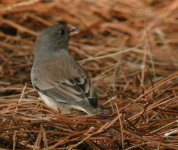The Oregons I get here all have varying degrees of brown on their backs and even on their heads. I think this may be an age thing, not necesarily a sub-species or variant thing, although it can point to intergrades, too. I've seen female Oregons with more of this brownish wash to their backs, heads and flanks than the males -- but not always. :-(
However, I'm also finding that "the book" keeps being rewritten about this species. What are there now, something like 14 variants of "Dark-eyed junco"? And even after a most interesting article about the "pink-sided" variant in, I think, "Birding" (I'll look up the exact ref if anyone wants it), I'm even more unsure what exactly constitutes a "pink-sided" bird since the amount of pinkish/buffy on the flanks is highly variable even on the Oregons, among other field marks.
Look forward to seeing your photo, too, KC. This winter I'm undertaking a project to photograph each junco in the yard to try to nail down what each variant is that we're getting here. I mean, 4 of the 5 "main" junco variants are fairly easy (red-backed, gray-headed, slate-colored and Oregon), but that pink-sided I'm less sure of.
EDIT: And there your photo is! Love cyber-cross-posting.


















